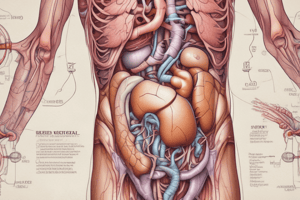Podcast
Questions and Answers
What is the primary function of the kidneys in terms of blood volume and pressure regulation?
What is the primary function of the kidneys in terms of blood volume and pressure regulation?
What is the minimum functional kidney mass required for survival?
What is the minimum functional kidney mass required for survival?
What is the role of the kidneys in regulating extracellular fluid pH?
What is the role of the kidneys in regulating extracellular fluid pH?
What is the primary component of metabolic wastes in urine?
What is the primary component of metabolic wastes in urine?
Signup and view all the answers
What hormone does the kidney secrete to regulate red blood cell synthesis?
What hormone does the kidney secrete to regulate red blood cell synthesis?
Signup and view all the answers
What is the primary function of the renal pyramids?
What is the primary function of the renal pyramids?
Signup and view all the answers
What is the role of the renal capsule?
What is the role of the renal capsule?
Signup and view all the answers
What is the function of the calyx?
What is the function of the calyx?
Signup and view all the answers
What is the location of the hilum?
What is the location of the hilum?
Signup and view all the answers
What is the function of the ureter?
What is the function of the ureter?
Signup and view all the answers
Study Notes
Functions of the Urinary System
- The urinary system is the major excretory system of the body, consisting of two kidneys, ureters, urinary bladder, and urethra.
- The kidneys filter a large volume of blood, collecting waste products and forming urine, which consists of excess water, ions, metabolic wastes, and toxic substances.
- As long as about one-third of one kidney remains functional, survival is possible.
- The kidneys' functions include excretion, regulation of blood volume and pressure, regulation of blood solute concentrations, regulation of extracellular fluid pH, regulation of red blood cell synthesis, and regulation of vitamin D synthesis.
Anatomy of the Kidneys
- The kidneys are bean-shaped organs, located behind the peritoneum on each side of the vertebral column, and surrounded by a layer of connective tissue called the renal capsule and a thick layer of adipose tissue.
- Each kidney has a medial side with a hilum, where the renal artery and nerves enter, and the renal vein, ureter, and lymphatic vessels exit.
- The hilum opens into a cavity called the renal sinus, which contains blood vessels, part of the system for collecting urine.
Internal Anatomy of the Kidneys
- The kidneys are organized into two major regions: the outer cortex and the inner medulla that surrounds the renal sinus.
- The cortex is the location for the blood-filtering structures of the kidney.
- The medulla is composed of many cone-shaped renal pyramids, whose bases project into the cortex.
- The renal pyramids transport fluid throughout the kidney and modify it into urine, which is then collected by ducts in the renal pyramids.
- The tips of the pyramids, the renal papillae, point toward the renal sinus, where urine is collected for movement to the urinary bladder.
- Urine from several calyces is emptied into a single, enlarged, funnel-shaped chamber called the renal pelvis, which narrows into the small-diameter tube called the ureter for transport to the urinary bladder.
Studying That Suits You
Use AI to generate personalized quizzes and flashcards to suit your learning preferences.
Related Documents
Description
Learn about the urinary system, its functions, and its components including kidneys, ureters, and the urinary bladder.




